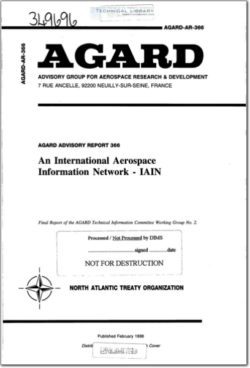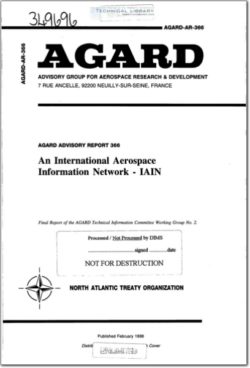AGARD-AR-366

- Version
- 102 Downloads
- 2.96 MB File Size
- 1 File Count
- March 9, 2016 Create Date
- March 9, 2016 Last Updated
An International Aerospace Information Network - IAIN

The aerospace industry is unique. In many
countries it leads all other industries in
expenditures for research and development (R&D);
it benefits heavily as a technological borrower from
developments in other industries such as
metallurgy, materials, chemicals, and petroleum; it
is characterized by a high degree of systemic
complexity embOdied in its products; and in many
countries, it is the beneficiary of federally firnded
R&D.
Worldwide, the aerospace industry is experiencing
significant changes. Increasing cooperation and
collaboration among nations has resulted in a more
international research, development, and
manufacturing environment, altering the current
environment of domestic and foreign aerospace
industries. International alliances have resulted in
a more rapid diffusion of technology, increasing
pressure on aerospace organizations to push
forward with new technological developments and
to take steps designed to maximize their inclusion
into the R&D process.
The conduct of aerospace R&D requires massive
quantities of highly diverse data and information.
The primary sources of aerospace and aerospace-
related information are derived primarily from
national programs and efforts; to a much smaller
extent, they are derived from international
programs.
The ability of aerospace engineers and scientists to
identify, acquire, and utilize scientific and technical
information related to aerospace and aerospace
related activities, is of paramount importance to the
efficiency of the R&D process. The role of
scientific and technical communication is thus
central to the success of the innovation process in
general, and the management of R&D activities in
particular. There is a vast and rapidlygrowing
amount of data and information concerning
aerospace; recent evolution of electronic networks
promises to provide us with a means to access and
use these massive volumes of data more
effectively. IAIN WD-Ol, Scope and Coverage of
Aerospace Information, provides a listing of
criteria for identifying information sources to
ensure comprehensive subject coverage.
| File | Action |
|---|---|
| AGARD-AR-366 An International Aerospace Information Network - IAIN.pdf | Download |

Comment On This Post